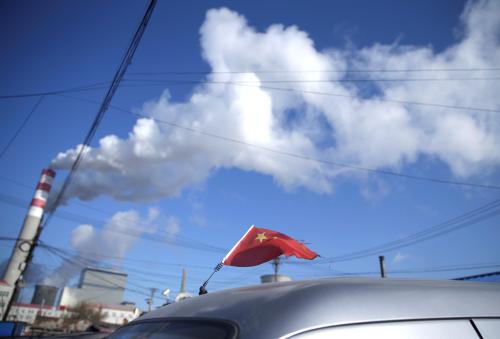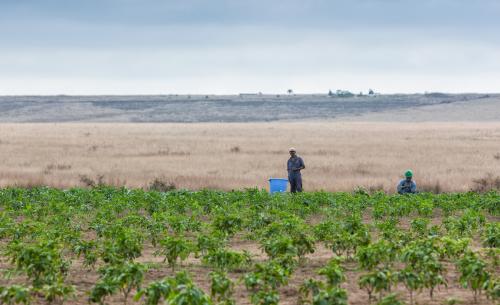Content from the Brookings-Tsinghua Public Policy Center is now archived. Since October 1, 2020, Brookings has maintained a limited partnership with Tsinghua University School of Public Policy and Management that is intended to facilitate jointly organized dialogues, meetings, and/or events.
The author is scientific director at FERDI (foundation pour les etudes et recherches sur le developpement international) and is attending the COP22 in Marrakech.
The Paris Agreement—which entered into force only on November 4—is already in jeopardy amid rumors that the U.S. might pull out. This could lead to a reduction in efforts by China and other nations. The Paris Agreement is really the first important step taken to limit temperature increase, and, as highlighted in the e-book “Towards a Workable and Effective Climate Regime,” by Scott Barrett, Carlo Carraro, and myself last year, it must meet two conditions that look increasingly difficult to attain. Meeting these conditions will be difficult for reasons related to science and to the U.S. election outcome.
In terms of science, one need look no further than see De Conto and Pollard (2016) to see new alarming estimates on likely sea level rise by the end of the century that signal far more must be spent to prevent the world’s coastal areas from submerging than previously thought. This will require more ambitious pledges from nations that signed on to the climate pact. For this to work, the agreement has to provide incentives for countries to limit their emissions beyond what is in their self-interest for the sake of their collective interests. This is a huge challenge. An even greater challenge is that the agreement must be perceived as fair by the poorer countries that have contributed the least to climate change, and are projected to suffer the most. This is because the poor are located in areas most exposed to climate risks and they are the least resilient to climate shocks. They need financial support to adapt, something far from guaranteed given signals that the U.S. may reduce its contributions to United Nations and other multilateral activities in support of climate action.
Slow progress at risk of stalling
Because the intensity of potential damage from climate change depends on the stock of CO2 emissions, the probability of damage is revised upwards through time. Hence the need to act now. Under optimistic assumptions and in the absence of carbon capture, to stabilize emissions by the end of the century to keep below the 2 degrees Celsius target, had emissions started falling at a constant rate in 2015 to reach zero net emissions by 21oo, emissions would have had to fall at the rate of 4.4 percent a year. Starting in 2020, the rate climbs to 6.3 percent; if we were to procrastinate further until 2030, the annual rate would have to be 25.5 percent, something unreachable short of geo-engineering.
As reviewed in a paper presented in Marrakech this week, though it has been close to a year on since the Paris Agreement was signed, countries have only inched toward providing the incentives needed to decarbonize our economies. The recent agreement on curbing aviation emissions and the Hydroflourocarbon (HFC) amendment to the Montreal Protocol will both contribute to reducing the growth of greenhouse gas emissions and will hopefully serve as “start and strengthen” initiatives. But these initiatives are in areas with the highest growth rates of emissions (above 10 percent per year recently) and they will only come into effect in 2020 and 2024 (or 2028).
Civil society at large is moving ahead
Cities (the “C40” initiative), the Carbon Asset Risk movement initiative, a private-sector led carbon divestment movement, and the Climate Disclosure Task Force (which is designed to deliver effective disclosure by companies that produce or emit carbon) are positive signs that “private authority” may be taking the lead.
These initiatives reflect the growing apprehension that business leaders and the public have about the future. Along with the process of assessment and review under discussion at Marrakech this week, these initiatives create opportunities for “naming and shaming” (the only incentive instrument to apply to sovereign states that have pledged to pursue domestic mitigation measures, with the aim of achieving the objectives of their nationally defined contributions, which, as noted by environmental law scholar Daniel Bodansky, is not a legal obligation). However, since the U.S. presidential election results, this gathering momentum will now slow, requiring stronger action tomorrow.
The uneven burden of damages from climate change calls for financial support to developing countries
Above all, the agreement has to be perceived as fair and it is here that a retrenchment will be costliest for all.
In Figure 1, total emissions in gigatons are indicated in the bubble, the size of each bubble being proportional to that region’s share in total emissions. Regions above the 45-degree line have above average per capita emission intensities. China is the heaviest emitter, followed by the U.S. and Europe and Central Asia. Sub-Saharan Africa—with a population share equal to that of Europe and Central Asia)—has an emission intensity of 0.84 tons per capita, about one-tenth the emission intensity of the Europe and Central Asia region.
Figure 1: CO2 emissions by region

Projected damages for 2050 are shown in Figure 2 under the assumption of no migration, with damages from extreme temperature measured by the predicted number of days per year outside the 90th percentile of the temperature distribution. This time, the bubbles are proportional to regional population shares, with the 45-degree line again indicating whether regions are predicted to get damages greater (above the line) or lesser (below the line) than their population share. Higher damages are predicted to occur in the most populous regions. Even if income per capita convergence continues, sub-Saharan Africa and South Asia will likely be the poorest regions and geographically have a large share of the low latitude regions (i.e., areas near the equator and that are controlled by tropical air masses), which means they will bear the brunt of climate change. Even with successful adaptation, migratory pressures toward regions with a more favorable climate and low population densities will be intense and conflicts will arise. Seas and walls will not suffice to separate the rich from the poor.
Figure 2: Projected damages from climate change in 2050

Financial transfer and climate finance
Financial transfers to low-income countries for adaptation and mitigation are the necessary glue to keep the agreement on track. Annual estimates are three or more times the annual ($100 billion) pledge made in 2009—estimates that will be revised upward as damages increase because of procrastination. If a widespread tax on carbon remains an essential ingredient of any workable long-run climate regime, in the meantime, transfers that avoid legislative processes such as linkages across carbon markets in different jurisdictions and other “workaround” measures must be considered. For instance, a cap-and-trade mechanism along the lines of the Clean Development Mechanism of the Kyoto Protocol is one option. But, to be effective, such a mechanism should include the large emitters. Another workaround is offsets from sectoral treaties like the HFC amendment to the Montreal Protocol that could be used to arrest deforestation, an activity that at least holds the promise of being verifiable.
The bottom line is that all avenues to effect transfers of the magnitude required will have to be explored to have any chance of meeting the ambitions of the Paris Agreement.







Commentary
Rising uncertainties about the climate regime in the aftermath of the US presidential election
November 15, 2016